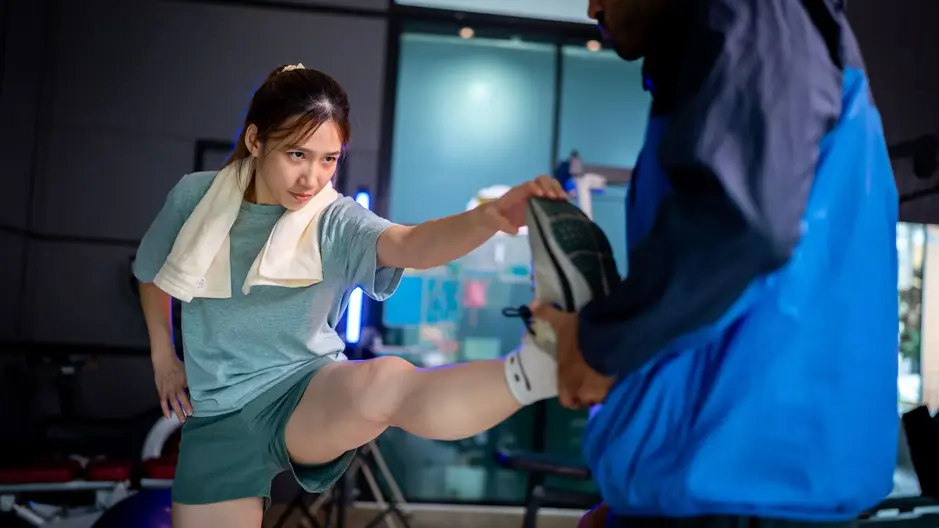Is Spinal Decompression Right for You?
If you’re dealing with chronic back or neck pain, you may be looking for effective treatment options beyond medication or surgery. Non-surgical spinal decompression is gentle, non-invasive, and helps reduce pressure on your spine and support healing, especially for conditions like herniated discs, sciatica, and degenerative disc disease.
At Prestige Health and Wellness, we use this therapy to help patients with conditions like herniated discs, sciatica, and degenerative disc disease. By gradually stretching the spine, spinal decompression can reduce pressure on nerves, improve circulation, and promote long-term relief.
What is Spinal Decompression?

While there are surgical approaches to decompressing the spine, there are many non-surgical approaches to spinal decompression that can be just as effective and less invasive.
Spinal decompression here at Prestige Health and Wellness is a non-surgical treatment using gentle stretching that helps reduce pressure on your spine, especially on the discs between the vertebrae, and can alleviate pain and help improve mobility.
How Spinal Decompression Works
Spinal decompression therapy at Prestige Health and Wellness is a safe, non-surgical treatment aimed at relieving pressure on the spine.
Here’s what you can expect during your sessions:
- Getting Set Up: You’ll lie on a specialized table, and a harness will be gently placed around your lower back and upper body to keep you comfortable and secure.
- Gentle Stretching: The table slowly moves to stretch your spine in a controlled way. This movement creates negative pressure in the spinal discs, which helps relieve pressure on nerves, reduce bulging or herniated disc material, and improve the flow of oxygen and nutrients to aid healing.
- Tailored to You: Your doctor will adjust the settings to ensure the treatment is customized for your needs. The stretching and movement will be carefully controlled to keep you comfortable while delivering maximum benefit.
Each session typically lasts 20 to 30 minutes. Most patients complete 20 to 28 sessions over 5 to 7 weeks for optimal results. Many times, our patients experience pain relief after the first few sessions. Follow-up visits may be scheduled to monitor your progress and adjust the treatment plan if necessary.
Conditions Treated with Spinal Decompression Therapy
Spinal decompression therapy can effectively treat many different spine conditions, including:
- Bulging or herniated discs
- Degenerative disc disease
- Pinched nerves
- Spinal stenosis
- Facet Syndrome
- Chronic back pain
- Chronic neck pain
- Postural issues related to spinal compression
Benefits of Spinal Decompression Therapy
- Relieving pressure on compressed nerves: Spinal decompression therapy gently increases space within the intervertebral disc, relieving pressure on the affected area.
- Improving circulation to the discs: Negative pressure pulls in oxygen, nutrients, and hydration, helping the disc heal. This process brings essential fluids into the disc, supporting cell growth and repair.
- Reducing disc bulging: The vacuum effect created within the disc encourages the bulging or herniated disc material to retract. Research shows that non-surgical spinal decompression can increase disc height, which is linked to pain relief, suggesting that decompression may help reduce disc-related back pain.
- Enhancing spinal alignment: By creating more space between the vertebrae and widening the discs and nerve openings, this therapy can help improve overall spinal alignment.
Integrating Physical Therapy with Spinal Decompression

Spinal decompression works best when combined with other therapies that support long-term healing and pain relief.
At Prestige Health and Wellness, physical therapy is often included as part of a complete treatment plan to strengthen your spine and prevent future issues.
Why Add Physical Therapy?
While spinal decompression helps relieve pressure and promote healing, physical therapy focuses on rebuilding strength, flexibility, and posture.
Together, they can help you:
- Strengthen the muscles that support your spine.
- Improve flexibility and movement.
- Reduce the chances of future back or neck pain.
What to Expect from Physical Therapy
Your therapist will guide you through exercises designed to match your needs and recovery goals. These may include:
- Gentle stretching to improve mobility.
- Strengthening exercises for core and back muscles.
- Posture training to help you move in ways that protect your spine.
A Comprehensive Approach to Healing
By combining spinal decompression with physical therapy, you’re not just addressing pain—you’re working toward better spinal health overall. This well-rounded approach can help you stay active, prevent future injuries, and support your long-term well-being.
Tips for Maintaining Spinal Health at Home

Incorporating these habits into your daily routine can help maintain good spinal health at home:
- Exercise and Movement: Participate in regular physical activity, focusing on exercises that build core and back muscle strength. Spine-friendly options like Pilates, yoga, and strength training help keep your spine strong and flexible. Also, take regular breaks from sitting, especially if you work in an office or at home.
- Proper Posture and Ergonomics: Be mindful of how you sit, stand, and lift. When lifting heavy objects, bend your knees, maintain a straight back, and lift with your legs. Try to maintain good posture to reduce strain on your spine and muscles.
- Wellness Strategies: Maintain a healthy weight to help reduce the pressure placed on your spine. Avoid smoking, as nicotine can limit blood flow to the spine. Additionally, reduce or eliminate inflammatory foods from your diet to support overall spine health.
- Sleep Hygiene: Use a firm or medium-firm mattress and pillows that properly support your spine. Create a calming bedtime routine and cut back on screen time before bed to help your body and mind by encouraging restful, spine-friendly sleep.
Find Relief from Back and Neck Pain with Non-Surgical Spinal Decompression Therapy
Don’t let chronic back or neck pain interfere with your daily life. Our expert chiropractors specialize in non-surgical spinal decompression therapy, offering a drug-free approach to alleviate pressure on your spine and nerves.
Whether you have herniated discs, sciatica, or general discomfort, we provide personalized treatment plans to help you heal and regain mobility.
Visit us at one of our convenient locations across NYC: Financial District, Hudson Yards, Chelsea, or Nomad. Call (917) 694-1565 or book your appointment online today and take the first step toward a pain-free, more active life.
Sources
Apfel, C. C., Cakmakkaya, O. S., Martin, W., Richmond, C., MacArio, A., George, E., Schaefer, M., & Pergolizzi, J. V. (2010). Restoration of disk height through non-surgical spinal decompression is associated with decreased discogenic low back pain: A retrospective cohort study. BMC Musculoskeletal Disorders, 11, Article 155.
Busch, R. E., III, Menon, P. G., & Sorin, S. L. (2023). A single session of spinal decompression with oscillation and videofluoroscopy. Rehabilitation Journal.
Choi, J., Lee, S., & Hwangbo, G. (2015). Influences of spinal decompression therapy and general traction therapy on the pain, disability, and straight leg raising of patients with intervertebral disc herniation. Journal of Physical Therapy Science, 27(2), 481–483.
Cleveland Clinic. (n.d.). Spinal decompression therapy. Cleveland Clinic.
Image Credit
1. Scientific Animations, CC BY-SA 4.0, via Wikimedia Commons.



